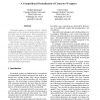Free Online Productivity Tools
i2Speak
i2Symbol
i2OCR
iTex2Img
iWeb2Print
iWeb2Shot
i2Type
iPdf2Split
iPdf2Merge
i2Bopomofo
i2Arabic
i2Style
i2Image
i2PDF
iLatex2Rtf
Sci2ools
ICSE
2003
IEEE-ACM
2003
IEEE-ACM
A Compositional Formalization of Connector Wrappers
Increasingly systems are composed of parts: software components, and the interaction mechanisms (connectors) that enable them to communicate. When assembling systems from independently developed and potentially mismatched parts, wrappers may be used to overcome mismatch as well as to remedy extra-functional deficiencies. Unfortunately the current practice of wrapper creation and use is ad hoc, resulting in artifactsthat are often hard to reuse or compose, and whose impact is difficult to analyze. What is needed is a more principled basis for creating, understanding, and applying wrappers. Focusing on the class of connector wrappers (wrappers that address issues related to communicationand compatibility),we present a means of characterizing connector wrappers as protocol transformations, modularizing them, and reasoning about their properties. Examples are drawn from commonly practiced dependability enhancing techniques.
| Added | 09 Dec 2009 |
| Updated | 09 Dec 2009 |
| Type | Conference |
| Year | 2003 |
| Where | ICSE |
| Authors | Bridget Spitznagel, David Garlan |
Comments (0)

